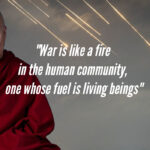“…There will be great suffering caused by our human-created climate change, but we may
need to go through this process in order to see the ‘light’.”
Nigel Crawhall (IUCN, CEESP representative, South Africa)
Ecological suffering is the result of centuries of abuse of our earth and environment. It is the effects of numerous overlapping developments (unsustainable for the most part). It results from violent actions, whether in the shape of colonialism, industrial development, wars, economic growth, the arms race or capitalist competition between states. More importantly, it is a flaw inherent in the global capitalist system—which is nevertheless seen as the best system to organize human life—and will bring down both capitalism and human survival if we act as if we don’t know about it. I explicitly name capitalism because without doing so any critique will be simply abstract, moralistic and toothless—such as blaming on greed in general or on particular greedy individuals, on human nature, on civilization, etc. No. Ecological suffering is the result of systemic violence rooted in the global political economy. Although our world cherishes diversity and choice, it is increasingly intolerant of any form of living that resists free market fundamentalism. Ecological suffering is happening on a daily level even if we feel that nothing is happening. Ecological suffering sustains the normalcy of our everyday life as we drive to work, eat our lunch, talk on our mobile phones, connect to the Internet, and so on. It is woven into our daily existence. As such, we don’t want our daily life to be disturbed and often act as if we don’t know about ecological suffering. But it is also experienced unevenly: the poor majority more so than the rich minority, who for now could still buy their way out of the problem; developing societies more than developed ones; and so on.
|
One of the main problems regarding ecological suffering is that it is a problem that has not been taken seriously by our political leaders or even by the people in general. |
One thing is certain: our ecosystem is crashing. What should be a circle of life, of interconnected life forms, have already started to work as individual parts going in different directions, leading to malfunctions and negative consequences in many parts of the system. At the Inter-Religious Dialogue on Climate Change and Biodiversity Conservation in September 2012, discussions were held on ecosystems, energy, and disasters.
A conclusion that was arrived at the conference was a simple but profound one: It is all connected; we are all connected. As I mentioned in my latest book Wisdom of Sustainability (2009), our world and nature works in the same way as the Wheel of Dhamma. The Wheel of Dhamma can be used to countenance the wheels of State and systemic violence. This is why tackling the environmental problem needs a religious or spiritual dimension.
Below, I will reflect on the problems and challenges we face in coping with the impending ecological catastrophe. I link the postponement of the crisis and sustainability with the cultivation of spirituality in ourselves; that is, to search for what has been uprooted and what we need to reclaim or retrieve. Bringing in Buddhist ethics, I will tease out how an interfaith approach to problem-solving can benefit our environment by pointing to some concrete suggestions.
 |
The starting points of this talk are drawn from The Wisdom of Sustainability and the Conference Overview of the Inter-Religious Dialogue on Climate Change and Biodiversity Conservation. And I will alternate between these two points, which also structure my talk. The Inter-Religious Dialogue was held in Sri Lanka in September 2012, at the Islander Center. It was organized by the International Network of Engaged Buddhists (INEB), the Sewalanka Foundation, International Union for the Conservation of Nature (IUCN) Sri Lanka National Office, and Commission on Environmental Economic and Social Policy (CEESP).
The concept of the conference grew out of recommendations at the INEB biennial conference in 2009. At this conference faith leaders, environmental and climate scientists, conservationists, and social activists from all over the world gathered to collaboratively explore the scientific foundations of climate change and biodiversity loss, its social, political, and economic drivers, the impacts of climate change on human societies and the environment, and the underlying human behaviors which contribute to climate change (Conference Overview, p.1).
The conference used three levels of engagement to frame the creation of actions by the participants. Through Micro-level (faith traditions, community action), Macro-level (policies, global influence), and Paradigm change (all levels of society), the participants of the conference created a roadmap for action based on six thematic areas: 1) Education; 2) Advocacy; 3) Personal change and eco-ethics; 4) Religious institutional change and eco-ethics; 5) Community change and modeling, and 6) Institutionalization of the network. In order to realize the roadmap for action, the participants set up the Inter-Religious Climate and Ecology Network (ICE Network) to further commit to the action model. The ICE Network will function as a media platform which will facilitate and support the six thematic areas
. The role of coordinating and following up these plans is filled by INEB. I will return to these key points toward the end of this talk.

In The Wisdom of Sustainability, I develop and elaborate on the work of E.F Schumacher and his ideas on Buddhist economics. By addressing the areas of Siamese history, peace-building, good governance, human security, sustainability, systemic violence, and the role of Buddhism in a world of change, I discuss alternatives to the mainstream development strategies and ways of being in our world. In a nutshell, I envision an updating of Buddhadasa Bhikkhu’s Dhammic Socialism as a solution to the multiple crises in the present world. I concur with Ken Jones’s idea of Dhammic modernity.
One of the main problems regarding ecological suffering is that it is a problem that has not been taken seriously by our political leaders or even by the people in general. Knowledge of the impending ecological catastrophe does not automatically or necessarily contribute to heightened political engagement. There are many reasons for this, including what is called “catastrophe fatigue” (i.e., the sense that catastrophe is expected and even normal), the feeling of impotence and cynicism, the failure to come up with adequate solutions, the lack of political will, etc. We have to stop doing things that compound these problems. We have to be more mindful in our actions. For politicians, environmental concern is often on the agenda, but more as a point of charity, and solutions so far have been ‘band-aid’ like, only temporary fixes to let the burden off their shoulders while structurally changing nothing. Proposed solutions have minimal impacts while the ecological problem is a maximal one. Also, we don’t have a proper institution that deals with the global environmental problems. We cannot rely on organizations such as the UN, where member countries have yet to endorse alternatives to neoliberal capitalism, where no great profits can be made from environmental issues and therefore they are not prioritized. This is why hope lies in the hands of smaller movements that can influence and spread actions, from a bottom-up approach at the local and regional levels. Breaks with the dogma of free market capitalism can also be seen at the local or regional level—for instance in Ladakh or in various parts of Latin America. But ultimately to solve the problem we must not forget that a new internationalism is badly needed. Local, regional or national institutions must serve as platforms that support this internationalism.
In The Wisdom of Sustainability (p. 23) I suggest that in the process of creating a culture of peace, we should apply the Four Noble Truths:
- Suffering exists.
- Suffering has causes.
- We can stop (re)producing the causes of suffering.
- A path of living mindfully can show us the way.
By applying these four truths to situations of conflict we can acknowledge the problem, find the root causes, and prevent unwanted consequences through mindful living—mindful of our actions, our environment, our brothers and sisters, and of our neighbors. What are the causes of ecological suffering? How can we stop or uproot them? To what extent are we part of the problem? To what extent are we reproducing ecological suffering through our way of life, political economy, etc.? To be mindful means to always insert ourselves in the big picture. To be mindful also entails critical thinking (including critical self-reflection) so that our actions will also be critical or mindful. We should desist from uncritical actions that reproduce ecological suffering. For instance, to what extent are our acts of resistance complicit in reproducing ecological suffering? To what extent is ethical consumption—buying organic food, green products, etc.—really a critical action that will help end ecological suffering? Is it really possible?
The First session of the Inter-Religious Dialogue conference was on “The Human Drivers of Climate Change and Biodiversity Loss.” Deforestation was especially discussed as this contributes to a major loss of species and at such a pace that nature has no chance to recover.
Grassroots movements can begin to prevent the causes of this suffering, by campaigning against dam projects, large scale industrial sites, etc. With the help and guidance from spiritual leaders we will find ways to reconcile people and nature. As E.F Schumacher writes in Small is Beautiful:
Everywhere people ask: ‘What can I actually do?’ The answer is as simple as it is disconcerting: we can, each of us, work to put our own inner house in order. The guidance we need for this work cannot be found in science or technology, the value of which utterly depends on the ends they serve; but it can still be found in the traditional wisdom of mankind (p.252).
A word of caution is needed here. That “guidance cannot be found in science and technology” does not mean that we will turn our backs on them. Science and technology are still the necessary tools to cope with ecological suffering. Furthermore, thanks to the Mind and Life Institute, founded by
His Holiness the Dalai Lama, which sponsors cross-cultural dialogues that bring together Buddhist scholars with Western scientists and philosophers, quite a number of leading scientists have become humbler, have started to see the limits of materialism and have come to appreciate the spiritual path beyond life and death. Some cognitive scientists have concluded that there is simply no one inside the brain to make decisions.
Next, the destructive patterns of consumerism need to be addressed. The ‘American Way of Life’ is the problem. At the session on Eco-systems, Energy and Disasters, the urgent need to take mitigation and adaptation actions to support vulnerable communities dealing with impacts occurring today and in the projected future was highlighted. The example of the Himalayas, which is most sensitive to climate change because of the high altitude, was given. This encouraged joint responses from neighboring countries because of the important interconnections between the Himalaya, the plains, and the coastal areas of Asia (Conference Overview, p. 16)
As mentioned earlier, there is a strong need to retrieve or reclaim our cultural and spiritual roots. In all religious traditions, the essence of spirituality lies in the teaching of interconnections between all living beings in the world. At the Inter-Religious Dialogue one session covered Religion, Faith, and Nature. One of the essential conclusions of the session is that “there is a pressing need for religious leaders to transcend beyond the labels of religion, to forget whatever outward differences they have [because of] their practices, rituals, places of worship, etc., and connect to the spirituality within us all” (ibid, p.23).
Today, many conflicts in Asia such as in southern Siam and in Burma are also related to religion. Although ethnicity partly plays a role in these problems, the root causes are more likely to be found in structural violence, the local social structure and the lack of good leadership and governance. If the younger generation is provided with an education that teaches them the core values shared by all religions, they may become agents of peace, working to dismantle violent structures. Movements and organizations facilitated by the Spirit in Education Movement (SEM), have already started such work, to educate people of what they should and can expect of each other and their leaders.
The second conclusion from this session concerns politics. There is a need to move beyond, not behind, representative democracy. More direct forms of democracy are needed. Representative democracy reduces the people to “the represented.” The people need to reclaim their sovereignty; they can be much more than merely “the represented,” or consumers choosing political parties during elections.
The third conclusion concerns the need to find alternatives to the capitalist system. So far ideological alternatives to neoliberalism have not been seriously explored, with a few exceptions such as the concept of Gross National Happiness as advocated by Bhutan. As for collective transformation, we can turn to the alternative models provided by Ladakh and Kerela in India. At the national level, we can look at the Bolivarian revolutions in Latin America. But virtually all major states in Asia or the Global South are capitalist in one way or another. The basic idea is that if one is concerned about the environment, one must find alternatives to capitalism, one must talk about a new political economy. A more simple way of living may also be necessary to help avert the ecological catastrophe. It’s high time for Buddhist economics.
At the Inter-Religious Dialogue a session was also devoted to the sharing participants’ experiences and political engagements. Three main questions were asked:
- Why can we not get a globally binding agreement on climate change and conservation?
- What can we do to bring about a change in policy, behavior and accountability?
- Where strategically should we focus our energy?
(Conference overview, p.28)
These are the very same questions that we should ask ourselves today.
In his opening speech at the COP18 in 2012, Shukran Jazeelan ended with the following words:
Let us speed up the transformation we know needs to happen.
Let us act even as negotiations continue toward a more robust climate regime.
Let us build creative partnerships that will drive courageous initiatives and innovation.
Let us abandon apathy and embrace ambition.
Let us take inspiration from the solutions we see around us and from the transformations that we know are possible.
Let us prove to future generations that we had the vision to see where we needed to go, and the wisdom to get there. And I count on your vision and your leadership.
The situation is catastrophic, but it is also the right condition to maintain mindfulness. We should not be too alarmed. The ecological catastrophe is imminent, but we also have the power to postpone it—perhaps indefinitely. This is the right sentiment to take to the COP19 later this year.
Lastly, at the Faith in Action sessions, one of the objectives was to move beyond discussion, into
action (2012, p.31). This is of course crucial but with a small reminder that without critical thinking or mindfulness, action becomes uncritical and changes nothing. This is not about the opposition between on one side thinking and talking and on the other side acting. The point is not about getting things done, but doing them meaningfully. The process of faith in action developed over two sessions, drawing out key themes and exploring what forms of collaborative actions are possible. They are summarized below:
- Education:
Create public awareness of climate change, biodiversity, ecology, and social justice through training spiritual leaders as well as ordinary people since they can be agents of change. This will be done through integration of indigenous wisdom and traditional community practices with climate change science, and the diffusion of local values to higher levels. This kind of climate change education can be integrated into formal education at all levels, employing various means and channels. By building connections between indigenous communities and religious leaders and policymakers, a sense of community or solidarity between different levels of society can be created, and organizations can build regional, national, and international networks. Education also entails finding alternatives to the free market model and way of being in the world; that is, cultivating a mindful and critical way of existence that paves the way for social transformation.
These actions are in line with what I mean by “Re-envisioning Education” in The Wisdom of Sustainability. It focuses on education as the empowerment of grassroots communities, but it also stresses the need to address both the inner and outer qualities, both spirituality and material conditions. Radical transformation of society requires personal and spiritual change—if not as a precondition, then as a simultaneous development. In a more secular language, Buddhism says self-critique must go hand in hand with social critique. Buddhists have accepted this idea for more than 2500 years. Those who want to change society must not only understand the predicaments of the contemporary world but also the dimension of inner, personal change. It is this personal transformation that true spirituality can provide.
- Advocacy:
On this topic the idea for action is to implement national training on advocacy methods, with specialized training on international advocacy, within the framework of social justice. The first step is to explore the stakeholders in climate change, which more or less include all fractions of society. Climate change is truly a common struggle we are facing. The next step is capacity-building for the different actors. Through law and policy enforcement, training on campaigning and advocacy, international exchange and exposure, skill training in gender, social impact and environmental impact assessments and many more, activities can be designed appropriately for different actors.
- Personal change and eco-ethics
It is here that religious and inter-religious actions can come to play a direct role. Through personal commitment to lower carbon emissions and lead a simpler life and by harmonizing Self and Nature, people can be mindful of their impacts on environment and be part of change. The next point is to strengthen relationships between climate change actors for long-term partnerships in action and solidarity. This can contribute greatly to the transformation towards a more sustainable culture among people if it is implemented.
- Religious institutional change and eco-ethics:
Religious institutions can reduce their negative environmental impacts and set a good example for surrounding communities, for example through the use of clean energy and creation of green spaces. In particular, the linking of religious institutions across faiths can facilitate common ethics and practices regarding environmental change; for instance, the integration of climate change and biodiversity loss into religious teachings.
- Community change and modeling:
Things that can be done include the establishment of eco-villages, organic and ecological small scale farming, artisanal fisheries, local ecosystem conservation, urban gardening, food security projects, indigenous knowledge system support and community forestry. These things are already being practiced in many places worldwide; through greater connections we can be inspired by one another.
- Institutionalization of the network:
This can be done through various forms of media, sharing campaigns, cross-Asian testimonies and building organizational capacity. The development and establishment of the ICE network is a move in this direction.
In conclusion, our world needs to be healed, everywhere, at every level. Our knowledge of what is to be done is always imperfect. We know that we need spiritual dimension as well as scientific and technological know-how. As flawed individuals, it is something difficult to succeed. At the same time, it is something that we cannot refuse to do. Buddhism teaches us that the process of healing our self must go hand in hand with making our planet a more livable place for generations to come. The problems that the world is facing are immense. Buddhists must not shy away from offering maximal solutions to these problems in order to make Buddhism relevant for the 21st century.
Sulak Sivaraksa
International Network of Engaged Buddhists
666 Charoen Nakhon Road
Klong San, Bangkok 10 600
Thailand






